Utlizing ‘AI’ Artificial Intelligence Software in the Hospitality Industry
Have you ever wanted more time and more help in your...
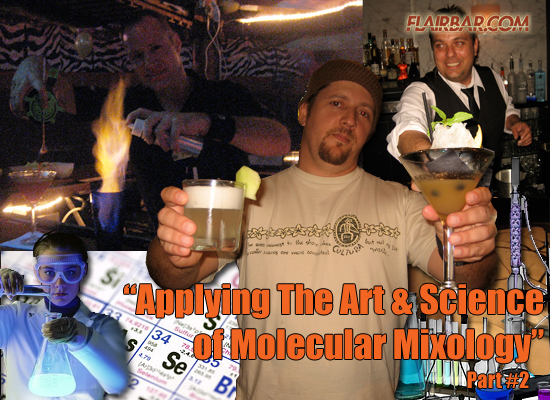
Welcome back to Part 2 of “Applying the Art & Science of Molecular Mixology”. In this installment we will explore further into the world of Molecular Mixology and other options for you to implement and experiment with.
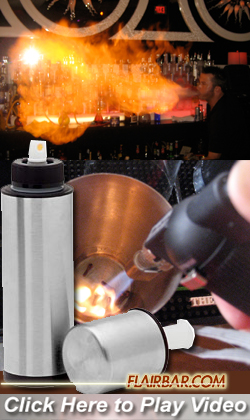 Flambé or sometimes-called Brule is the next element of Molecular Mixology we will be focusing on. Flambé is when you use alcohol as a heating element to change the characteristics of your ingredients. We touched on this briefly in the last article and we will now go more in depth with it.
Flambé or sometimes-called Brule is the next element of Molecular Mixology we will be focusing on. Flambé is when you use alcohol as a heating element to change the characteristics of your ingredients. We touched on this briefly in the last article and we will now go more in depth with it.
Flambé is a great way to add some Flair to your Mixology skills. Everybody loves fire… and when your guests see you utilizing fire like a flamethrower to make their cocktails that much better, you will definitely grab their attention as well as hopefully their pallets. Flambé is relatively easy but dangerous method of Molecular Mixology because there is fire involved and should be used with caution. What you will need to accomplish this is a Brulee torch or a “Constant Spray Mister” generally used for spritzing oil in the culinary world. I picked mine up at “Bed, Bath & Beyond” for around $10.00 USD. Then you just fill the mister with your desired alcohol. In this example I will be using Grand Marnier. Close the spritzer tightly and give it a few pumps to create pressure so when you press the button on top, the Grand Marnier will dispense in a fine mist (much like blowing fire with Bacardi 151 from your mouth) making it easier to ignite and heat up your desired elements.
Now lets demonstrate how to apply this to an actual drink. Here is the recipe for my “Heering Cherry Lime-Aid”. First in a mixing glass add 2 lime wedges, four cherries and raw sugar. Take your mister filled with Grand Marnier and hold your lighter close to the glass and ignite the flame with your mister. Continually heat up the limes and cherries while caramelizing the raw sugar. Next add 1 1/4oz SKYY Raspberry Infusion Vodka and 3/4oz Heering Cherry liqueur. Muddle the ingredients and fill your mixing glass with ice. Add equal parts Finest Call Sweet & Sour Mix and cranberry juice. Shake vigorously and strain over fresh ice in an oversized rocks glass. Next top the cocktail with a Heering Cherry foam and enjoy without a straw. Delicious! The texture of the foam at first followed by the taste of the cocktail and then finished with the texture from the caramelized sugar in the cocktail is a roller coaster for your palette. All thanks to Molecular Mixology. To watch the cocktail being made live just click the picture on the right.
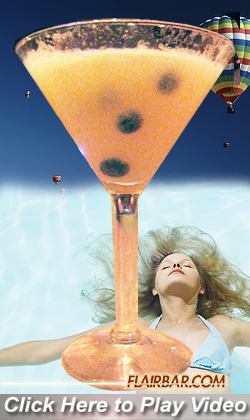 Suspensions are an element of Molecular Mixology that are very eye appealing and somewhat new to me when I first sat down and started wrighting this article. So I went to a long time friend of Flairbar.com and mine Cesar Romero. This is what Cesar had to say about Suspensions…
Suspensions are an element of Molecular Mixology that are very eye appealing and somewhat new to me when I first sat down and started wrighting this article. So I went to a long time friend of Flairbar.com and mine Cesar Romero. This is what Cesar had to say about Suspensions…
Another part of Molecular Mixology are Suspensions. This type of technique consists of adding elements or components to thicken your liquid base by using gelatins or alginates. The reason for thickening your liquid base is to create a holding element or in this case its name means suspend any other ingredients, elements, fruits, a second drink or any garnish you might like add to your drink. The heavier the element you are suspending the thicker your drink will be.
Suspensions are in a way a new technique and the best way to get through it is by practicing and improving every time you use these elements by taking notes of amounts, servings, measurements and find the right balance in creating suspended cocktails. Few elements like temperature also affect the consistency of the cocktail. So you might have to be careful in your environment because these gelatins are ingredients that basically must be made at the time your guest orders these cocktails due to the reason to avoid the breakdown of the ingredients over time and temperature change. So these cocktails cannot be prepared too much ahead of time.
Now lets demonstrate how to apply this to an actual drink. In our example will create a suspended cocktail with garnish. We will proceed to combine 2oz of Smirnoff Watermelon and 2oz of fresh melon juice. Next add 2 ounces of unflavored and uncolored powdered gelatin. These elements most be cold. After adding the gelatin you most stir continuously until you reach the desired consistency then proceed to add your second element (small blueberries) in this case the garnish, which will be suspended into your cocktail base. Pretty Cool! Suspensions are a great way to add new appeals to your cocktails. To watch the cocktail being made live just click the picture on the right.
So now that you a better understanding of Molecular Mixology, the question is… “How do I apply this to a real working bar?” The answer is simple, just like any good bartender sets his bar for the night. The key is preparation and organization. The more you have prepped ahead of time, the less you have to do while working a busy shift behind the bar. “If you have time to muddle, you have time for Molecular Mixology”. That’s what I usually tell someone when they are contemplating applying this science behind their bar. So lets start with preparation. First off Foams are one of the easiest applications of Molecular Mixology to use behind the bar if done right. You prep your Foams ahead of time (I like to make mine at home an hour before I have to leave for work then finish getting ready and then head to work with my Foams that were chilling in the fridge for an hour). So now when I get to work I place the anispooners in the cooler and I’m ready to go. The organization being, I know exactly where my anispooner and all my tools are at any moment so I can simply reach for them without wasting time looking for them. It takes seconds to add the Foams to my cocktails during the shift and add new complexity and flavors to play with.
The same with Caviars & Pearls, prep them ahead of time and bring them in an easy to use container to you can quickly apply them to your cocktails while working. Flambé’s take a little longer to do properly but the reaction and excitement you get from the crowd is generally worth it. It works out well when you knock out 3 or 4 at once. Remember the more people you attract and keep at your bar and entertain, the higher your sales will be and in return the more tips you will make.
Suspensions at first glance took too much time away from other guests at my bar and sacrificing everybody else’s service. With sticking to my belief that it is possible to make high volume hand-crafted quality cocktails, I researched this technique in further detail. With the help of my sister Jennifer Husted and her culinary background coupled with my beverage background, we finally came up with a way to streamline the application of Suspensions and this part of Molecular Mixology. I’m a huge fan of prepping and preparing as much as you can ahead of time to save time and effort during a busy shift. When it came to Suspensions we tried many different techniques involving everything from a handheld portable blender to different proteins and temperatures. What we came up with in the end was simple, quick and convenient while still applying this application of Molecular Mixology behind any bar.
Our solution… “Suspension Syrup”. Now we made it as simple as pouring another ingredient as part of your cocktail. With utilizing “Suspension Syrup” we were able to suspend different fruits and elements just like mixing the gelatine by hand but streamlining the process and keeping truer to the natural consistency of the drink without drinking a drink that tasted like you were ingesting nothing but orange juice pulp and suspended fruit. Now we will share with you the Husted process for “Suspension Syrup”…
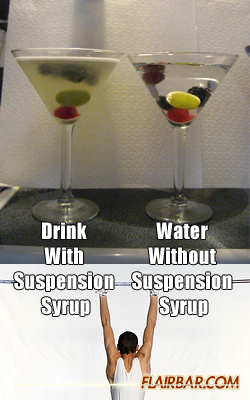 We wanted to make it simple, understandable, accessible and affordable while still being quick and efficient. So we started off with the readily available gelatine powder sold worldwide in most grocery stores. With keeping the process simple, most of the gelatine powder we worked with came in 1/4oz packets of four to a box equaling a total weight of 1oz. With the packets of gelatine powder already measured out for you, we felt like that would be our starting block. With many trial and errors we came up with these next steps. In a saucepan, add 1 liter of water, sprinkle two 1/4oz packets (totaling a 1/2oz) of gelatine powder slowly and evenly into the water without having it stack up too much in one spot. Next heat up the saucepan on your stovetop on medium heat, stirring occasionally until the gelatine powder is all dissolved (this usually takes about 6-8 minutes). Then take the saucepan off the stovetop and let it cool down for a bit. Next we took an empty Finest Call bottle and funnel to transfer the contents of the saucepan into the ready to use bartender friendly container. Presto! “Suspension Syrup”! The first successful drink we made with our “Suspension Syrup” was a martini with 1 1/4oz Absolut Vanilia, 3/4oz Finest Call Sweet & Sour Mix, 1oz water and 1oz “Suspension Syrup” combined in a cocktail shaker with ice. Shaken hard for thirty seconds and strained into a chilled martini glass. The cool side effect with utilizing our “Suspension Syrup” is that because of the protein added, once you give it a hard shake you will also have a nice thick foam on the top layer of your drink once you strain it. Next we suspended fresh blackberries into the drink. At first we gently placed them on the surface of the drink to suspend them on top next we dropped them in a little harder an they were suspended in the middle of the drink, then we finally dropped them in with force to get them to settle at the bottom of the drink. The foam and suspension lasted for over four hours until we finished the drink. So now the outcome was we had blackberries suspended all throughout our martini using basically the same amount of time it would have taken to make the same drink with blackberries settled at the bottom of the martini glass. Just one way to apply the art & science of Molecular Mixology behind your bar.
We wanted to make it simple, understandable, accessible and affordable while still being quick and efficient. So we started off with the readily available gelatine powder sold worldwide in most grocery stores. With keeping the process simple, most of the gelatine powder we worked with came in 1/4oz packets of four to a box equaling a total weight of 1oz. With the packets of gelatine powder already measured out for you, we felt like that would be our starting block. With many trial and errors we came up with these next steps. In a saucepan, add 1 liter of water, sprinkle two 1/4oz packets (totaling a 1/2oz) of gelatine powder slowly and evenly into the water without having it stack up too much in one spot. Next heat up the saucepan on your stovetop on medium heat, stirring occasionally until the gelatine powder is all dissolved (this usually takes about 6-8 minutes). Then take the saucepan off the stovetop and let it cool down for a bit. Next we took an empty Finest Call bottle and funnel to transfer the contents of the saucepan into the ready to use bartender friendly container. Presto! “Suspension Syrup”! The first successful drink we made with our “Suspension Syrup” was a martini with 1 1/4oz Absolut Vanilia, 3/4oz Finest Call Sweet & Sour Mix, 1oz water and 1oz “Suspension Syrup” combined in a cocktail shaker with ice. Shaken hard for thirty seconds and strained into a chilled martini glass. The cool side effect with utilizing our “Suspension Syrup” is that because of the protein added, once you give it a hard shake you will also have a nice thick foam on the top layer of your drink once you strain it. Next we suspended fresh blackberries into the drink. At first we gently placed them on the surface of the drink to suspend them on top next we dropped them in a little harder an they were suspended in the middle of the drink, then we finally dropped them in with force to get them to settle at the bottom of the drink. The foam and suspension lasted for over four hours until we finished the drink. So now the outcome was we had blackberries suspended all throughout our martini using basically the same amount of time it would have taken to make the same drink with blackberries settled at the bottom of the martini glass. Just one way to apply the art & science of Molecular Mixology behind your bar. ![]() On a side not when implementing Mango, Kiwi, Pineapple or Figs with the “Suspension Syrup” it doesn’t always work quite as well. Also keep in mind the shelf-life is good for only a couple of days.
On a side not when implementing Mango, Kiwi, Pineapple or Figs with the “Suspension Syrup” it doesn’t always work quite as well. Also keep in mind the shelf-life is good for only a couple of days.
Deconstructions do take some time to make. From my experience these are hard to prepare without sacrificing service to everybody else at the bar. If its not busy at your bar then by all means go for it… you can really make some incredible drinks applying these applications. The way I generally handle those situations are, if I’m too busy at the bar and the majority of guest service will be sacrificed then I’m honest with my patrons that ordered a drink that will take me literally 8 minutes to prepare only focused on that drink and tell them I’m sorry but too busy to prepare that right now and I generally suggest something else with a Foam or something else that I can knock out right away without sacrificing everybody else’s service at my bar. They are generally happy with this and end up trying a new cocktail while still coming back later to try the original cocktail they had intended to order. So now service isn’t sacrificed and I’m educating the patrons as well. Generally a win-win situation for everybody.
Now keep in mind a vast majority of bartenders in the United States have this stigmatism about muddling and making frozen drinks. It’s not until they truly care about the cocktail that they seem to have their eyes opened and get past this. It took an article that Philip Duff wrote for our April 2005 issue of Flairbar.com that my eyes finally began to open after reading this statement ”What’s the downside of working for tips? Well, you’ll usually be making shit drinks. You can make decent tips working in great bars, but typically the best tips are earned in busy places that make crap drinks: cheap booze, pre-mixes, no muddling, no fresh fruit or herbs, just turn and burn, shake and churn, thanks very much, see you again chief. The reason shit drinks = great tips is because shit drinks = quick drinks and quick drinks = lots of tips, especially in North American where many bartenders expect to make about $1 per drink in tips”. If you get a chance, check out the controversial article in our archives. I bartend in a very high volume bar and with the right preparation and organization still have time to make quality hand crafted cocktails along with the common Absolut Cape Cod. Another example would be John Lermayer down at “The Florida Room” at the Delano Hotel in Miami, Florida. The team of bartenders there all create quality hand crafted cocktails in a high volume atmosphere. Something I am a huge advocate of… It can be done! It all depends on how much do you care about the cocktail?
This was just a taste of the many aspects of Molecular Mixology and applications of utilizing them in a true working bar… high volume or not. We hope you will explore more with the application of this knowledge behind your bar and continue crafting great cocktails. Post your recipes on our “Cocktails” page and share them with the world while getting credit for them. Until then use these techniques as garnishes to use with your already great cocktail menu. It got me to think outside of the glass…
“Texture” A Hydrocolloid Recipe Collection
An excellent eBook edited by Martin Lersch that shares recipes for Molecular Gastronomy & Mixology. A great resource for learning more and becoming more invovled with the possibilities out there.
Big thanks to Cesar Romero who shared it with us, so we can share it with you.
|
“Flairbar.com’s Interview with Belvedere Brand Ambassador and Master Mixologist Claire Smith” Flairbar.com had a chance to sit down with Belvedere Brand Ambassador and Master Mixologist Claire Smith as she shares with us her insights into the wonderful world of Molecular Mixology. |
||
|
“The Mojito Of The Future” From Bacardi & Eben Freeman Through Bacardi a lot of research has gone into this new trend of couture cocktails and to celebrate 146 years of heritage, Bacardi worked with world renowned molecular mixologist Eben Freeman they have refined recipes and techniques to create the first Bacardi Mojito of the Future. |
||
|
“Bols Amsterdam presents an Introduction to Molecular Mixology” Bols explores Molecular Mixology with Herve This, celebrated chemist and pioneer of Molecular Gastronomy. You can also notice regular Flairbar.com contributor and Bols ambassador Philip Duff in the background. |
||
|
|
The New York Times Magazine: The Edible Martini
Chef/mad scientist Dave Arnold of the French Culinary Institute has figured out how to vacuum infuse a martini inside a cucumber.
“Alginate Spheres”
Blueberry syrup, sodium alginate and calcium chloride is all you need to make these spheres that look a little like caviar.
To Flair and Friends…
ROB HUSTED
Have you ever wanted more time and more help in your...
MANGO MAGIC: Marco Estrada, Brownsville, TX 1 ½ oz Aviation Gin ¾...
ALOE WOK: Olya Sabanina, Saint Petersburg, Russia 1 1/3 oz Aviation Gin...
We have all strived to become better at our craft, or else,...
About the author, Elton Marvin Jr. has worked in the food and...
From starting out picking up a Flairco bottle after watching the movie...
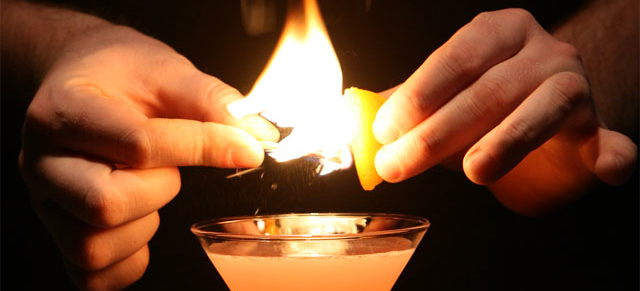
Your cart is empty.
Click “Play” on the video above.
Click “Play” on the video above.
Click “Play” on the video above.

